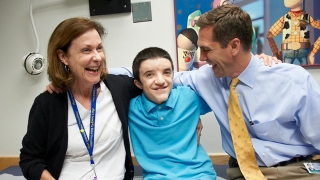Linear Scleroderma
What is linear scleroderma
Scleroderma is a rare autoimmune disease in which an overproduction of abnormal collagen causes normal tissues to be replaced with thick, dense scar tissue that can affect underlying bones and muscles if left untreated.
There are two forms of scleroderma: localized scleroderma (primarily affects the skin, most common form found in children) and systemic sclerosis (a chronic, degenerative disease rarely seen in children).
Symptoms
Linear scleroderma is a progressive loss of subcutaneous fat with pigment changes in the skin. It is a type of localized scleroderma in which the area of skin affected appears in a band. It typically first appears in young children on one side of the body. It can affect the trunk, arms, legs, face or neck, or multiple parts of the body. Symptoms of localized scleroderma may include:
- Shiny, thickened patches of skin
- Discolored (lighter or darker) skin
- Joint tightness
Scleroderma can result in cosmetic problems, scarring, growth abnormalities and limited motion if joints are affected. Symptoms may resemble other medical conditions, so always consult your child’s physician to confirm her diagnosis before pursuing treatment.
Diagnosis
Diagnosis of linear scleroderma is usually based on the changes in the skin and internal organs. Because linear scleroderma is often associated with a positive antinuclear antibody, an antibody test may help distinguish the type of scleroderma present.
In addition to a complete medical history and physical examination, your child may undergo additional diagnostic testing, including an echocardiogram, electrocardiogram (EKG or ECG) or X-ray. An EKG can detect abnormal heart rhythms which may be caused by changes in the heart muscle tissue due to scleroderma. X-rays may detect changes in bone and soft tissues, the gastrointestinal tract, and the lungs caused by scleroderma
Linear scleroderma is sometimes confused with Parry-Romberg syndrome because both conditions are characterized by the same progressive loss of subcutaneous fat. Like Parry-Romberg disease, the onset of linear scleroderma occurs is in childhood and may involve the facial region. Unlike Parry-Romberg disease, there is no optic nerve dysfunction, burnout phase and generally no muscle or bone atrophy.
Medical professionals who are experienced in diagnosing and treating children with linear scleroderma and Parry-Romberg syndrome will be able to distinguish between the two and provide an accurate diagnosis.
Treatment
Treatment for scleroderma depends on your child’s overall health and the severity of the condition. Treatment may include:
Medication — Your child’s medical team may recommend medications such as nonsteroidal, anti-inflammatory medications (NSAIDs) or corticosteroids to relieve pain; penicillamine to slow the thickening process and delay damage to internal organs; or immunosuppressive medications.
Skin protection — Sunblock or protective padding can be used to protect the affected area.
Physical therapy — Physical therapy and exercise can be used to maintain muscle strength.
Surgery — Surgical treatment may involve fat transferred by injection or excision of isolated patches of abnormal tissue. In the fat transfer technique, fat is aspirated from elsewhere in the body, cleaned, and reinjected into the tissue under the skin to add volume, contour and shape. This is a minimally invasive procedure and usually can be done on an outpatient basis.
If large areas of discolored, irregular skin are involved, the preferred treatment option may be direct excision of the abnormal tissue with closure of the adjacent normal skin. While this procedure may leave a scar, the scar is typically less noticeable than the existing deformity. This procedure is also typically done on an outpatient basis, and your child can return home the same day.
In severe atrophy, large amounts of tissue may be transferred to the affected area using microsurgical techniques. This transferred tissue often comes from the trunk or legs. The tissue may be placed deeply to add volume, closer to the surface of the skin to replace damaged skin, or both.
Why choose us
The timing of treatment can be important in the management of linear scleroderma. At The Children’s Hospital of Philadelphia (CHOP), our team is experienced in caring for children at every age, from birth to young adulthood.
CHOP’s experienced plastic and reconstructive surgeons work closely with parents and referring physicians to addresses all related medical or psychosocial problems that your child may experience related to linear scleroderma. It is important to receive treatment at a dedicated children’s hospital where coordinated, multidisciplinary care is available across all pediatric specialties. At CHOP, your child will have access to the nation’s top pediatric specialists.
Reviewed by: Scott Bartlett, MD and Jesse Taylor, MD
Date: March 2014
Reviewed by Scott P. Bartlett, MD, Jesse A. Taylor, MD

